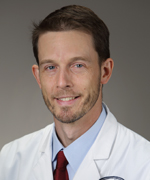Meet the 2014 NIH Lasker Clinical Research Scholars
Investigating Sickle-Cell Disease, Cancer, and Addiction
Congratulations to Hans Ackerman, Andrea Apolo, and Falk Lohoff, the newest NIH Lasker Clinical Research Scholars.
Ackerman (National Heart, Lung, and Blood Institute) is studying how metabolic and genetic factors affect blood flow in people with sickle-cell disease, with a special emphasis on stroke and kidney injury in adults. He also is working with the Sickle Cell Research and Treatment Center in Bamako, Mali, to identify the major causes of death and disability in children with sickle-cell disease.
Apolo (National Cancer Institute) is developing and designing clinical trials to test novel agents for the treatment of urologic cancers. In particular, she is working to develop new bladder cancer–targeted therapies such as anti-angiogenesis compounds, inhibitors of the cellular Met receptors, and immunotherapeutic combinations.
Lohoff (National Institute of Alcohol Abuse and Alcoholism) is focusing on heritable and nonheritable genetic aspects that influence the onset, progression, and treatment of alcohol-use disorders and addictions. Findings from these studies are translated into human clinical studies using diverse approaches, including molecular biomarkers, pharmacogenetics, epigenetics, and functional-imaging genetics.
The Lasker program, now in its fourth year, is a collaborative initiative of the NIH and the Albert and Mary Lasker Foundation that will nurture the next generation of clinician-scientists. Talented early-stage clinical researchers are selected to do independent research for five to seven years at the NIH. After completing their initial term, scholars will either remain at NIH as independent investigators, or join the faculty of an extramural research institution where they can receive up to five more years of NIH financial support. NIH funds the research and provides the scholars access to the resources of the NIH Clinical Center. The Lasker Foundation provides the opportunity for the scholars to attend its annual awards luncheon, where they can present their results and interact with senior colleagues.
The following is a lightly edited version of interviews with Ackerman, Apolo, and Lohoff.
HANS ACKERMAN, M.D., D.Phil., M.Sc.
Lasker Clinical Research Scholar; Chief, Physiology Section, Sickle Cell Branch, National Heart, Lung, and Blood Institute

Education: William and Mary, Williamsburg, Va. (B.S. in biology); University of Oxford, Oxford, England (M.Sc. in human biology; D.Phil. in human genetics); Harvard Medical School, Boston (M.D.)
Training: Residency in internal medicine at Massachusetts General Hospital (Boston); fellowship in critical-care medicine at NIH Clinical Center; research fellowship in NIAID’s Laboratory of Malaria and Vector Research
Came to NIH: In 2007 for subspecialty training in critical-care medicine and to begin research on endothelial biology in malaria and sickle-cell disease; in 2011 became assistant clinical investigator in NIAID’s Laboratory of Malaria and Vector Research
Outside interests: Working creatively with his hands—cooking, painting, landscaping, gardening, home remodeling, and restoring old cars; playing sports (especially soccer and cycling) with his three sons; enjoying music, good food, and travel with his wonderful wife
Website: https://irp.nih.gov/pi/hans-ackerman
How did you become interested in your field?
When I was growing up, my family lived in rural central and western Africa. I think that experience is an ever-present reminder of how many families in the world (including in the United States) live: without a steady source of income, adequate nutrition, or protection from disease. I’ve chosen to focus on sickle-cell disease and malaria because there is not only an urgent need to improve access to screening, education, and preventive measures, but also a tremendous opportunity to make a difference with improved treatments developed through scientific discovery.
What was your work at NIH after completing your residency?
I came to the NIH as a clinical fellow to study endothelial biology and pathogenesis of malaria and sickle-cell disease. After completing my clinical fellowship, I joined Thomas E. Wellems’s laboratory (NIAID), where I focused on the mechanisms of vascular dysfunction during malaria infection in African children. Children with severe malaria develop an inability to perfuse vital organs, and that inability appears to be regulated in part by endothelial nitric oxide. Over the past two years we have worked with the Blantyre Malaria Project in Malawi to quantify vascular function in children with cerebral malaria. We found that these children have an impaired ability to increase blood flow to tissues that are oxygen starved. We have also performed parallel studies of adults with sickle-cell disease at the NIH Clinical Center and found they also have an impaired ability to re-oxygenate muscle.
What’s the research you are currently doing at NIH?
I am continuing my studies of sickle-cell disease and malaria, focusing on areas that are similar between the two diseases. Sickle-cell disease became common in areas of the world where malaria is prevalent because carriers of the sickle-cell trait are protected from complications of malaria and are more likely to survive. Sickle-cell disease and malaria have an evolutionary link and many of the same disease-causing mechanisms. Both are primarily diseases of red-blood cells and cause them to become stiffer, stickier, and more fragile.
In order to understand the mechanisms underlying vascular dysfunction in sickle-cell disease and malaria, we will also study how naturally occurring genetic differences in healthy people change nitric-oxide signaling and vasodilation responses in blood-vessel walls. Once we understand how these common genetic changes affect blood-flow regulation, we will examine how they affect the severity and outcome of patients’ sickle-cell disease. Ultimately, we hope to develop drugs that mimic vascular-protective genetic factors; these drugs could potentially prevent or treat the vascular complications of sickle-cell disease or malaria.
What made you decide to come to NIH?
NIH provides an unparalleled opportunity to link basic-science discovery with clinical and translational studies to help the patients I care about.
What is most exciting about your work?
I’m always learning something new from my patients or my fellows.
Is there anything you can look back on now and realize it was significant?
I worked really hard to get into a great immunology laboratory as an undergraduate student. However, I had no idea how much time it took to do science well; I had to drop my honors thesis and thought I would never be able to do basic-science research again. I settled into a one-year anthropology program instead of beginning doctoral studies, but six months later I found myself back in the laboratory sequencing genes and looking for genetic factors of severe malaria. As a graduate student, I learned how exciting research can be—not just the excitement of discovery but of dreaming up a hypothesis and pursuing it. These experiences guide me when I am working with students and fellows here at NIH. I also recognize how much fun science can be and what a privilege it is to pursue.
ANDREA B. APOLO, M.D.
Lasker Clinical Research Scholar; Chief, Bladder Cancer Section, Genitourinary Malignancies Branch, National Cancer Institute–Center for Cancer Research

Education: Lehman College, New York (B.S. in chemistry and biochemistry); Albert Einstein College of Medicine, New York (M.D.)
Training: Residency in internal medicine at New York–Presbyterian Hospital/Weill Cornell Medical Center (New York); fellowship in medical oncology at Memorial Sloan-Kettering Cancer Center (New York)
Before coming to NIH: Clinical research fellowship in genitourinary oncology at Memorial Sloan-Kettering Cancer Center (2006–2009)
Came to NIH: In January 2010 as an assistant clinical investigator in NCI’s Medical Oncology Branch
Outside interests: Running and spending time with her family
Website: https://irp.nih.gov/pi/andrea-apolo
How did you become interested in your field?
I worked with a community medical oncologist in the Bronx while completing a summer preceptorship in my freshman year of college. There for the first time I saw the great struggle cancer patients face with their therapies, and I realized the critical need to find more-effective therapies with less toxicity. When I was awarded a scholarship to come to the NIH the following summer under the Undergraduate Scholarship Program (UGSP), I chose to work at the NCI to learn more about the research being conducted in tumor biology.
What was your work before you came to NIH?
I was fortunate to work with one of the world leaders in bladder cancer research while at Memorial Sloan-Kettering Cancer Center in New York. There I learned how to write protocols and to conduct clinical trials and understand the important issues that need to be addressed in studying and treating this disease. My research focused on developing genetic biomarker signatures for tumor surveillance and on incorporating new imaging modalities in clinical trials for new potential treatments. I was also involved in the development of the first clinical trials looking at targeted anti-angiogenic agents in patients with bladder cancer.
What’s the research you are doing at NIH?
I am interested in improving the treatment and survival of patients with genitourinary tumors. My research involves designing clinical trials to test novel agents for the treatment of urologic cancers. My primary research interest is in bladder cancer (urothelial carcinoma). In particular, I am working to develop new bladder-cancer therapies that use targeted agents including anti-angiogenesis compounds and inhibitors of Met receptors. I am planning to test these targeted compounds individually or in combination with immunotherapies. We are also working on developing predictive and prognostic biomarkers in muscle-invasive and metastatic disease.
What made you decide to come to NIH?
I came to the NIH to fulfill a service commitment from the UGSP scholarship. I stayed at the NIH because there is no other place like it in the world to conduct translational and clinical research. I also stayed because of the people: My colleagues at the NIH are so committed to scientific research that it makes the NIH a great environment in which to work.
What is most exciting about your work?
I get to take part in the evolution of cancer therapy. I don’t just treat patients with standard anticancer therapies—I am involved in finding more-effective, “smarter” therapies that may improve outcomes and change the standards of care.
FALK W. LOHOFF, M.D.
Lasker Clinical Research Scholar; Chief, Section on Clinical Genomics and Experimental Therapeutics, Laboratory of Clinical and Translational Studies, National Institute on Alcohol Abuse and Alcoholism

Education: Free University of Berlin, Berlin (undergraduate work); Humboldt University of Berlin, Berlin (M.D.)
Training: Residency training in psychiatry and a fellowship in neuropsychopharmacology at the University of Pennsylvania (Philadelphia)
Before coming to NIH: Assistant professor of psychiatry and attending physician at the University of Pennsylvania (2007–2014)
Came to NIH: In August 2014
Outside interests: Music, arts, fencing, and working out
Website: http://1.usa.gov/1AwIXZm
How did you become interested in your field?
My interest in psychiatry started to develop during medical school when I learned about the various serious mental illnesses for which very limited treatment options were available. I was struck by the fact that several psychiatric illnesses such as schizophrenia, bipolar disorder, and addiction are highly heritable, yet no universal genetic risk variants had been identified. I became intrigued by the possibility that there must be underlying molecular genetic makeups that could explain complex phenotypes and that identification of these variants would potentially help in diagnosis as well as in the development of new drugs.
Did your view of psychiatry change after beginning your studies?
I entered into psychiatry training with enthusiasm only to later appreciate how complex psychiatric phenotypes really are and how complex human molecular genetics are. Ultimately, I was surprised to learn how little we know so far about the underlying neurobiology of psychiatric disorders.
What was your work before you came to NIH?
After completing my residency training in psychiatry and a fellowship in neuropsychopharmacology at the University of Pennsylvania, I stayed on as faculty and started my own lab. My interest was in genetics, psychopharmacology, and personalized medicine for the evaluation, diagnosis, and treatment of psychiatric disorders and addictions. I wanted my work to span bench to bedside, so I provided care for patients with mood and anxiety disorders, involved myself in clinical trials testing new treatments for these disorders, and collected biospecimens and DNA samples for molecular analyses.
What’s the research you are doing at NIH?
My research is focused on translational medicine and spans areas of molecular genetics, epigenetics, imaging genetics, pharmacogenetics, and clinical experimental trials. I oversee preclinical studies and translational clinical studies that focus on genomics and epigenetics related to the pathophysiology and treatment of alcohol-use disorders and addictions. In our preclinical work, we are using a wide array of methods (including human population genetics, genome-wide genotyping approaches, next-generation DNA and RNA sequencing, and epigenetic-proteomic profiling) to identify molecular mechanisms that are involved in addictions. We translate the findings into human clinical studies using molecular biomarkers as well as pharmacogenetic, epigenetic, and functional-imaging genetic approaches. Our clinical studies include early phase 1 and phase 2 proof-of-concept studies of experimental novel therapeutics guided by molecular-biomarker profiling.
What made you decide to come to NIH?
The Lasker Clinical Research Scholars Program is a fantastic opportunity for me to carry out meaningful human research focused in the area of experimental medicine. The program provides unparalleled resources and an outstanding environment at the NIH Clinical Center.
What is most exciting about your work?
My vision over the next several years is to expand our current understanding of the underlying neurobiology of drug addiction by using personalized genomic and translational approaches. Given the substantial variability in phenotype, even within a single addiction diagnosis and substantial comorbidities, new approaches are needed to dissect the neurobiology of addiction. This work will, on the one hand, include large-scale interrogation of the genome and epigenome, but also require carefully designed prospective clinical trials of individuals with known functional genetic risk profiles that are then assessed with regards to circuitry variation, pharmacological response, and clinical outcomes. With my background—in clinical psychiatry, basic science, pharmacogenetics, and experimental clinical trials—I hope to bridge these areas and facilitate translational collaborations.
To read about NIH’s first NIH Lasker Clinical Research Scholars—Nehal Mehta (National Heart, Lung, and Blood Institute) and Jessica Gill (National Institute of Nursing Research)—in the January-February 2013 issue of the NIH Catalyst, go to https://irp.nih.gov/catalyst/v21i1/nih-lasker-scholars.
This page was last updated on Tuesday, April 26, 2022
